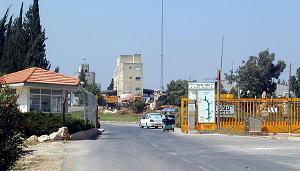 |
Kfar Giladi |
| Our home for the next two days was a Kibbutz
Hotel at a Kibbutz very close to the border with Lebanon in the North.
We weren't sure what to expect but in the event it was a reasonable quality modern hotel which just happened to be run by a Kibbutz. Entry into the Kibbutz (see above) was rather like entry into a secure camp and in fact that was exactly what it was. At various times, the Kibbutz has been under attack from the North, so it is capable of being closed up and defended. To get to the hotel, we had to pass through almost the complete Kibbutz. What started out as a collective farm has long since diversified into many new areas including light industry, a quarry and of course the hotel. |
|
| The hotel and the kibbutz was set in extensive
gardens in a very attractive part of Israel with hills all around and a
distant view of snow on the top of Mount Herman.
In fact, I got rather more time than I expected to enjoy the it. When we woke up on Friday morning, Sue was not well at all. We had to call in a doctor and she spent a good part of the day in bed. (More or less from the top the photographs show)
|
|
| While Sue was recovering, I want for a couple
of walks around the Kibbutz. The first was relatively short, but far
enough to encounter the barbed wire fence and watch towers. From time to
time there was air activity, so even when we were there the tensions
with Lebanon were evident.
Strangely, while we were in Israel, Cathy was visiting a friend in the Lebanon. Although they were staying near Beirut, they did come within about 20 miles of the border with Israel on one occasion. |
|
| Walking around the Kibbutz, I was struck by the abundance of flowers, wild and cultivated. | |
| On my longer walk, I took the road around the outside of the Kibbutz and then walked back across the centre, passing the farm buildings on the way. | |
| It was very hot. The sun was beating down with virtuallu no breeze. This delightful lizard was taking advantage of the heat to warm up. | |
| These birds were perched on the power cables into the village. | |
| One of the industries of the Kibbutz involves quarrying. These natural shapes discovered in the quarry are displayed in an open air display just inside the main entrance. | |
| Although everything was peaceful, we were
reminded that this is not always the case. Kfar Giladi is about as far
North as it is possible to get in Israel before the Lebanese border.
These pictures show the view towards the border and the town on the hill
is in Lebanon. The scar across the landscape is the line of the border, with two barbed wire fences separated by a no mans land, periodically patrolled by armoured vehicles and tanks. |
|
| Over towards the East lies Mount Hermon. This is the highest point in Israel. In the winter it is home to Israel's only ski resort. In April, there was still some snow to be seen. | |
| These pictures were taken just outside the Kibbutz from the road we travelled to get into it and look down towards the local town a few miles South. | |
| The Tel Hai cemetery just outside of the Kibbutz honours people who fell defending Israel. | |
| The valley below the Kibbutz is home to the vineyards, another of it's major sources of revenues. During a talk on Kibbutz operation, the leader explained how the irrigation system is controlled by cell phone calls directly to the pumps. |
Last updated on November 07, 2004